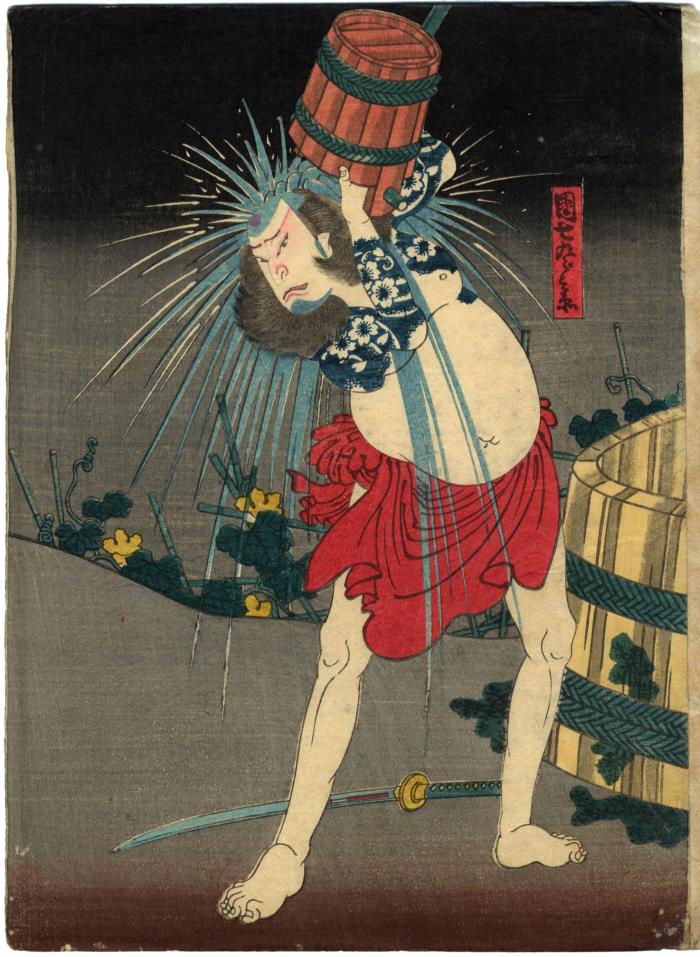Utagawa Hirosada (歌川広貞: 1810-1864) (artist early 1810s - early 1860s)
Nakamura Utaemon IV as Danshichi Kurobei (団七九郎兵衛) - left panel of a diptych
05/1850
7.375 in x 10 in (Overall dimensions) Japanese woodblock print
Unsigned (the signature appears on the right-hand panel)
Philadelphia Museum of Art - full diptych
Hankyu Culture Foundation - 1866 Yoshitaki print after this model
Hankyu Culture Foundation This print was published to commemorate a performance of Natsumatsuri Naniwa Kagami at the Naka Theater in Osaka in 5/1850. In this scene Kurobei is seen washing the blood of his father-in-law off his body after he has slain the old man.
Published in Ikeda bunko, Kamigata yakusha-e shūsei, vol. 4, 2003, #296.
Illlustrated in:
1) Schätze der Kamigata: Japanische Farbholzschnitte aus Osaka 1780-1880, MNHA (Musée national d'histoire et d'art Luxembourg), 2012, p. 120, #258.
2) Hirosada: Ōsaka Printmaker by Roger Keyes, 1984, #37b, p. 108. Keyes says this print was published by Meikōdō.
3) The whole diptych in color in ‘The beauty of cruelty. The origins of Danshichi and his evolution as a tattooed anti-hero in Natsu matsuri’ by John Fiorillo in Andon 87, December 2009, p. 39.
4) In a color reproduction in Ukiyo-e to Horimono: the history and art of Japanese Prints and Tattooing by Jan van Doesburg, 2013, cat. 026. The full diptych is shown.
5) In black and white, the full diptych, in The Theatrical World of Osaka Prints by Roger Keyes, the Philadelphia Museum of Art, 1973, no. 70, page 183.
****
As note above the Ikeda Bunko identifies this image as coming from the play Natsumatsuri Naniwa Kagami. However, Roger Keyes in his entry in The Theatrical World of Osaka Prints, where it is illustrated in full on page 183, that it comes from Yadonashi Danshichi Shigure no Karakasa. He also dates it to 5/1851.
This is Keyes description:
"Danshichi Kurobei, a samurai, has disguised himself as a fishseller to facilitate the search for a precious sword that was once in his custody. He regains the sword with the help of a bathhouse owner, Jisuke, but the certificate that must accompany it remains in the hands of Kazuemon, a rival suitor for a bathhouse attendant, Tomi. Jisuke promises Kazuemon that Danshichi will give up Tomi in exchange for the certificate, and feigns coldness to Danshichi to gain Kazuemon's confidence. The stratagem works, and Jisuke recovers the certificate, but before he can explain his pretended hostility to Danshichi, the latter kills him, enraged by his seeming disloyalty. Realizing, too late, that Jisuke had been helping him all along, Danschichi commits suicide in atonement.
In the present scene, Danshichi has just murdered Jisuke beside a well. It is a hot summer night, and sounds of a festival procession reach him from the other side of the melon patch as he douses himself with water. Utaemon actually used water on stage in this scene and this may be one reason why he was criticized for his "over-realism"... The tattoo on his body was an innovation to the role. There is a program for this performance showing Danshichi stabbing Jisuke and a character named Kyūshichi in the darkness beside the well.
Nakamura Utaemon IV, who left Osaka in 1838 after a wage dispute, returned triumphantly in 1850. The tone of theatrical criticism and the height of Utaemon's acclaim at this time can be judged from a two-page broadside titled "Short Criticisms of Nakamura Utaemon" [Nakamura Utaemon Ryaku Hyōban], which was published in 1852 shortly after the actor's unexpected death."
Later Keyes added:
"This chūban diptych has a red hand-stamped seal of the publisher or retailer, Meikōdō. The title of the print, Natsumatsuri Chūkōden ("The Summer Festival: A Tale of Loyalty and Filial Piety"), is a curious combination of the popular title of the play "The Summer Festival," with the edifying fictitious titles that were added to prints between 1847 and early 1849 to avoid the suspicion that they were actor portraits."
Danshichi Kurobei (団七九郎兵衛) (role)
actor prints (yakusha-e - 役者絵) (genre)
Nakamura Utaemon IV (四代目中村歌右衛門: 1/1836-2/1852) (actor)
Tattoo (genre)
